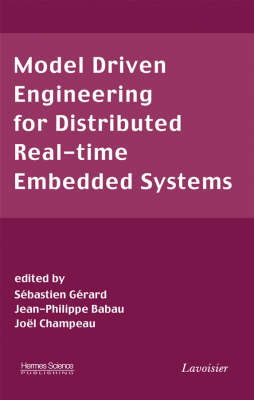
Model Driven Engineering for Distributed Real-Time Embedded Systems
ISTE Ltd and John Wiley & Sons Inc (Verlag)
978-1-905209-32-3 (ISBN)
Sebastien Gerard is associated with the INSA of Lyon, France.
INTRODUCTION Chapter 1: Model Engineering: From Principles to Platforms
Introduction
Definitions and concerns
AMMA: a model engineering platform
Conclusion
Acknowledgments
Bibliography
Chapter 2: Model-Driven Development of Distributed Real-time and Embedded Systems
2.1. Introduction
2.2. Overview of Video Distribution Case Study
2.3. Applying CoSMIC to Address Video Distribution Needs
2.4. Related Work
2.5. Concluding Remarks
2.6. References
Chapter 3: Model Transformation
3.1. Why should we transform models?
3.2. Role of model transformation in the software lifecycle
3.3. Basics of model transformation
3.4. Classification of model transformations
3.5. Conclusion
3.6. References
Chapter 4: Modeling Dependability Features
4.1. Introduction
4.2. Separating Crosscutting Features
4.3. Aspect Models
4.4. Composing Models
4.5. Using the AOM Approach to Separate Middleware-Specific Features
4.6. Related Work
4.7. Conclusion
4.8. References
Chapter 5: Model-Driven Systems Engineering: SysML & the MDSysE Approach at THALES
5.1. Introduction
5.2. The SysML Profile for Systems Engineering
5.3. Building a Model-Driven Systems Engineering methodology: the MDSysE approach
5.4. Tooling model-driven systems engineering: the MDSysE Tools
5.5. Perspectives
5.6. References
Chapter 6: Maturity of Model Driven Engineering for Embedded Control Systems from a Mechatronic Perspective
Introduction
Evolution of model-driven engineering practice for ECS
A contextual perspective to MDE
A definition of Model-Driven Engineering for ECS
A model of MDE maturity
MDE maturity in practice
Discussion
Conclusion
Acknowledgments
Dictionary
Index / Keywords
References
Chapter 7: Real-Time Components & Contracts
7.1. Introduction
7.2. Contract Aware Components: The four levels of Contracts
7.3. Implementing contract-aware components
7.4. Predicting extra-functional properties of an assembly
7.5. Conclusion
7.6. References
Chapter 8: The Think Component-Based Operating System
8.1. Introduction
8.2. The Fractal Component Model
8.3. The Think Framework
8.4. Think experiments
8.5. Analysis
8.6. Conclusion
8.7. Acknowledgments and availability
8.8. Bibliography / References
Chapter 9: Model-Driven Schedulability Analysis
9.1. Introduction
9.2. Real-time scheduling
9.3. The MDD process
9.4. Conclusions
9.5. References
Chapter 10: Performance Analysis based on the UML SPT Profile
10.1. Introduction
10.2. Performance Models
10.3. UML models with performance annotations
10.4. UML to LQN Transformation
10.5. Performance Model Validation
10.6. Conclusions
10.7. Acknowledgments
10.8. References
Chapter 11: Code Generation for Embedded Systems
11.1. Introduction
11.2. Code Generation
11.3. Rialto as an Intermediate Language for Code Generation
11.4. Rialto in Code Generation
11.5. Conclusions
11.6. References
Chapter 12: Model Driven Architecture for Intensive Embedded Systems
12.1. Introduction
12.2. MDA and co-design
12.3. The Transformation Engine: ModTransf
12.4. Models and Metamodels
12.5. Application of MDA transformations
12.6. Conclusion
12.7. References
Chapter 13: Spidergon: A NoC Modeling Paradigm
13.1. Introduction
13.2. The Spidergon NoC Architecture
13.3. Spidergon NoC Modeling
13.4. Design Space Exploration Using NoC Metamodels
13.5. Conclusion and Extensions
13.6. References
Acknowledgments
| Erscheint lt. Verlag | 14.9.2005 |
|---|---|
| Verlagsort | London |
| Sprache | englisch |
| Maße | 163 x 238 mm |
| Gewicht | 573 g |
| Themenwelt | Mathematik / Informatik ► Informatik ► Theorie / Studium |
| Technik ► Elektrotechnik / Energietechnik | |
| ISBN-10 | 1-905209-32-0 / 1905209320 |
| ISBN-13 | 978-1-905209-32-3 / 9781905209323 |
| Zustand | Neuware |
| Haben Sie eine Frage zum Produkt? |
aus dem Bereich


